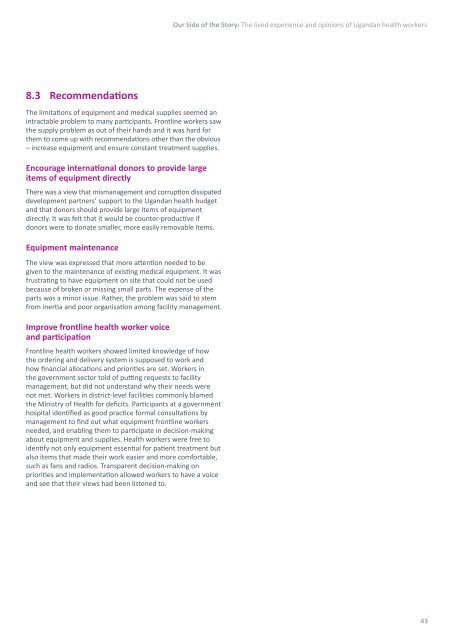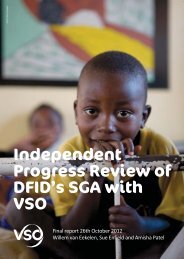<strong>Our</strong> <strong>Side</strong> <strong>of</strong> <strong>the</strong> <strong>Story</strong>: The lived experience and opinions <strong>of</strong> Ugandan health workersWorking without protective wear – gloves, aprons, gumboots,shoes, masks – was a huge risk, especially for midwivesworking in <strong>the</strong> dark: “You are ba<strong>the</strong>d in blood.” Lacking gloves,midwives even used <strong>the</strong>ir own clo<strong>the</strong>s and plastic bags to grasp<strong>the</strong> baby during delivery. Workers in some rural facilities in <strong>the</strong>government sector provided <strong>the</strong>ir own work clo<strong>the</strong>s as, it wassaid, <strong>the</strong> Ministry <strong>of</strong> Health no longer supplied uniforms.In <strong>the</strong> government sector <strong>the</strong>re was widespread frustration atnot being able to work effectively: “What really hinders my workis lack <strong>of</strong> some equipment” and “The equipment does not allowyou to do what you are supposed to do.” Nurses spoke aboutthwarted pr<strong>of</strong>essional fulfilment. Willing to work and capable <strong>of</strong><strong>of</strong>fering a full service, <strong>the</strong>y felt “handicapped” and “disappointed”.As a result, work was nei<strong>the</strong>r enjoyable nor happy: “If I amprovided with what I am supposed to use, I can enjoy <strong>the</strong> work”and “You can’t really be happy in such conditions, but would behappier with equipment to do your best.”Frontline medical doctors spoke <strong>of</strong> “struggling with <strong>the</strong> minimum”and <strong>of</strong> feeling “deflated” by poorly maintained equipment suchas x-ray machines with blown bulbs or no chemical to print <strong>the</strong>film: “You wake up and have <strong>the</strong> same problem, you go home,you come back and it has not changed.” Doctors wanting <strong>the</strong>satisfaction <strong>of</strong> doing <strong>the</strong>ir best for <strong>the</strong>ir patients spoke <strong>of</strong>frustrations such as a lack <strong>of</strong> diagnostic equipment or facilityfor blood counts. Managers recognised that medical doctors“eventually lose morale” when <strong>the</strong>y are unable to operate on apatient because oxygen or sutures are missing, and that beingunable to apply knowledge was “very demotivating”.Failing <strong>the</strong>ir patients greatly distressed nurses and doctors.Patients died because <strong>of</strong> <strong>the</strong> lack <strong>of</strong> essential supplies: “Wewould have saved that life if we had oxygen. It stresses you.”A lack <strong>of</strong> diagnostic equipment lost lives too: “The patientprobably would have survived if you were able to investigate.”Government sector workers faced a dilemma when <strong>the</strong>facility ran out <strong>of</strong> supplies. User charges were abolished in <strong>the</strong>government sector 127 and health workers told <strong>of</strong> prohibitionson asking patients to go and buy missing items: “It is veryannoying, you go home dissatisfied.” The medical doctor has aduty towards <strong>the</strong> patient’s health: “What do you do? Ask <strong>the</strong>patient to buy or see <strong>the</strong>m get worse?” The o<strong>the</strong>r option was“to be kind” and refer <strong>the</strong> patient to a higher-level facility.Participants spoke against <strong>the</strong> policy: “I don’t feel it wrong toask a patient to buy needles in order to help <strong>the</strong>m,” and it wasclear that patients in some facilities were being asked to buysupplies. It was hard to ask a patient to buy items that shouldhave been provided free <strong>of</strong> charge: “I don’t want to be <strong>the</strong> oneto say go and look for a canula.”Participants in facilities with relatively good supplies welcomedrelief from <strong>the</strong> stresses <strong>of</strong> telling patients to buy <strong>the</strong>ir own.They also spoke <strong>of</strong> pride in a facility that did not force patientsto spend <strong>the</strong>ir little money on intravenous fluids, canulas,gloves, dressings and <strong>the</strong> like. There was praise for imaginativemanagement that solved temporary supply problems byborrowing from o<strong>the</strong>r facilities.The impact on attitudes, behaviour and practicesParticipants working in <strong>the</strong> private and not-for-pr<strong>of</strong>it sectorsspoke frankly about effects <strong>of</strong> shortages <strong>the</strong>y had seenduring <strong>the</strong>ir time in government facilities. They told <strong>of</strong> nursesforgetting what <strong>the</strong>y had been taught in training schools andsome not working as a result, so projecting a bad image to <strong>the</strong>community which in turn made nurses feel not respected andprompted <strong>the</strong>m to leave. Participants in <strong>the</strong> government sectordid not identify <strong>the</strong>se effects. However, <strong>the</strong>re was a suggestionthat nurses were reluctant to come to work and face patientsand <strong>the</strong>ir relatives knowing that essential supplies were lacking:“Staff don’t want to come in and look at a mo<strong>the</strong>r with a dyingchild and no canula to give intravenous fluids.”The impact on community relationsHealth workers felt blamed for <strong>the</strong> lack <strong>of</strong> supplies andresented accusations <strong>of</strong> <strong>the</strong>ft. The patient’s attitude changedwhen asked to buy supplies: “You feel bad when somebodyis not appreciating what you are doing.” Patients’ carers weresometimes angry and violent, such as a husband who hit amidwife when asked to buy gloves.There were fears <strong>of</strong> personal repercussions if <strong>the</strong> rule wasdisregarded and <strong>the</strong> patient was asked to buy supplies: “TheGovernment is going to see you as a bad person.” Staff in onefacility were stressed by <strong>the</strong> arrest <strong>of</strong> a health worker whoasked a patient to buy essential supplies. The view <strong>the</strong>re wasthat local political candidates had set <strong>the</strong> arrest in motion todiscredit <strong>the</strong> incumbent leader.127. User charges were abolished in 2001 in all government facilities except private wings in hospitals.42
<strong>Our</strong> <strong>Side</strong> <strong>of</strong> <strong>the</strong> <strong>Story</strong>: The lived experience and opinions <strong>of</strong> Ugandan health workers8.3 RecommendationsThe limitations <strong>of</strong> equipment and medical supplies seemed anintractable problem to many participants. Frontline workers saw<strong>the</strong> supply problem as out <strong>of</strong> <strong>the</strong>ir hands and it was hard for<strong>the</strong>m to come up with recommendations o<strong>the</strong>r than <strong>the</strong> obvious– increase equipment and ensure constant treatment supplies.Encourage international donors to provide largeitems <strong>of</strong> equipment directlyThere was a view that mismanagement and corruption dissipateddevelopment partners’ support to <strong>the</strong> Ugandan health budgetand that donors should provide large items <strong>of</strong> equipmentdirectly. It was felt that it would be counter-productive ifdonors were to donate smaller, more easily removable items.Equipment maintenanceThe view was expressed that more attention needed to begiven to <strong>the</strong> maintenance <strong>of</strong> existing medical equipment. It wasfrustrating to have equipment on site that could not be usedbecause <strong>of</strong> broken or missing small parts. The expense <strong>of</strong> <strong>the</strong>parts was a minor issue. Ra<strong>the</strong>r, <strong>the</strong> problem was said to stemfrom inertia and poor organisation among facility management.Improve frontline health worker voiceand participationFrontline health workers showed limited knowledge <strong>of</strong> how<strong>the</strong> ordering and delivery system is supposed to work andhow financial allocations and priorities are set. Workers in<strong>the</strong> government sector told <strong>of</strong> putting requests to facilitymanagement, but did not understand why <strong>the</strong>ir needs werenot met. Workers in district-level facilities commonly blamed<strong>the</strong> Ministry <strong>of</strong> Health for deficits. Participants at a governmenthospital identified as good practice formal consultations bymanagement to find out what equipment frontline workersneeded, and enabling <strong>the</strong>m to participate in decision-makingabout equipment and supplies. Health workers were free toidentify not only equipment essential for patient treatment butalso items that made <strong>the</strong>ir work easier and more comfortable,such as fans and radios. Transparent decision-making onpriorities and implementation allowed workers to have a voiceand see that <strong>the</strong>ir views had been listened to.43
















